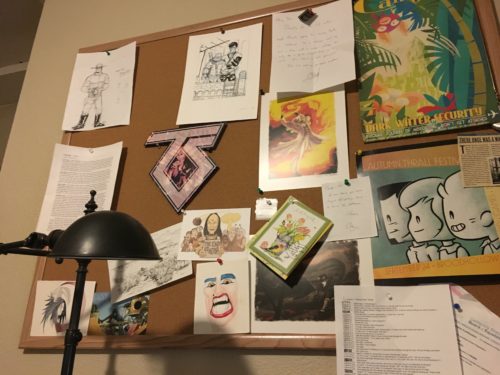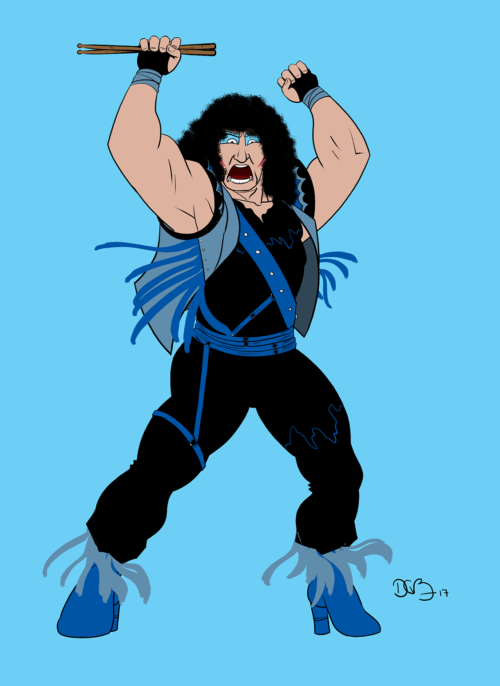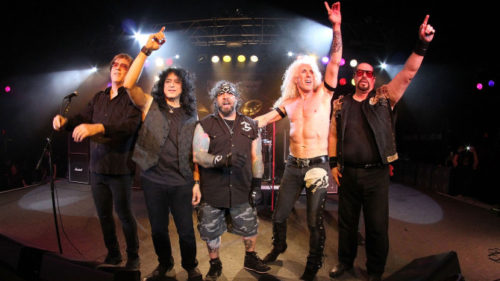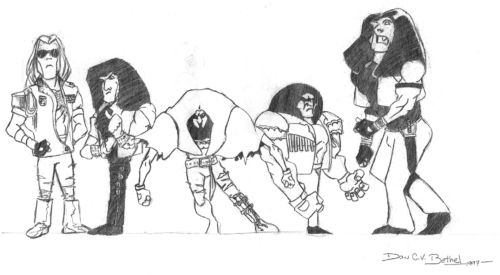Sketch Fridays #47 – A. J. Pero
Ghost notes are a fascinating musical technique I’ve always known about, as a player, but was only recently made cognizant of when, earlier this summer, I somehow happened upon a video of funk drummer, Bernard Purdie, instructing the viewer about how he discovered ghost notes and how he incorporates them into his playing. Technically, they are unaccented notes; soft, fill-in notes played between the main, accented beats. On guitar, they can be scratched, palm-muted notes thrown in between notes or chords, but ghost notes are most associated with drumming. They are flavor that fill out a song and rhythm that make it sound more alive and vivid to the ears of a listener. While it would be easy for a listener to not really hear them, if they were outright removed from a song, their absence would be palpable and the music would feel much more lifeless and inert.
As much of a fan as I am of Twisted Sister, I readily admit that I left them behind at points in my life for various reasons. Months, perhaps even a year (at most) has gone by when their music didn’t grace my ears. Most likely, the longest gap was after I started playing guitar; I was a devotee of the blues and, later, classic/southern/blues-rock––genres that didn’t really overlap with Twisted Sister at all. I would come back to them when I was feeling down, dejected, lost, or nostalgic, and it always worked at bringing up my spirits.
To be blunt and obvious, this band’s music and its members are the ghost notes in the rhythm of my life––always there even if unheard or unnoticed. No matter how hard I ran into the weeds of the delta blues or into the open arms of ’70s folk rock or ’80s Clapton, the simple songs of Twisted Sister was always playing, unaccented, underneath all of it. Whenever––and I mean every time––I came back to Twisted Sister’s music, it acted as a balm. Their songs always made me feel better and scolded myself for not coming back to the music earlier. They were always the home I could return to, even when the actual home I grew up in felt distant and foreign after awhile. Eventually, though, the effect would wear off and their thunderous stomp would dwindle behind whatever beat guided my aim, moving me on to something else, hearing them underneath but not recognizing it or simply just tuning them out.
A.J. Pero was the last addition to the “classic” lineup of Twisted Sister. He became the youngest member of the band and, according to the documentary, We Are Twisted Fucking Sister, he was the fit the band had been looking for as they cycled through a long list of drummers previous to his arrival. A tiny but burly man, he hit the drums with the power and steadiness that Dee’s songs needed, and it is arguable that it was his drums that made “We’re Not Gonna Take It” as memorable as it was even when put against the lyrics/melody, and chord progression. If anything, that song is a testament to Pero’s intelligence as a drummer: he hit the drums solidly with enough flare to be interesting but not enough to overwhelm the song. His talent percolated underneath the primal stomp of every song they recorded.
But he was, apparently, more than just the drummer. The rest of the band regularly refers to him as “the nice one,” best exemplified by his behavior during the band’s wilderness years after their breakup. He was the one member to keep in touch with all of the others (despite the fact that he left the band a year before they officially called it quits), just checking in and relaying the health and happiness of each to whomever he was catching up with. This generosity of personality is clear in the videos the band made, as well. Already wacky beyond belief, he was the one band member that actually seemed at home in the live-action cartoons Dee Snider created for the band, culminating in the video for the ballad, “The Price.” In it, the band rehearses for a big arena show. They’re all in street clothes (albeit still ridiculous) and are being very serious as they sing this very serious song (note: a ballad not about love, girls, sex, cars, or drinking––who knew). And then… A.J. shows up wielding two oversized drumsticks and gives them a go on his kit.
A.J. Pero died suddenly in 2015, and it was the first real loss I experienced of a celebrity I truly cared about, and it hit me pretty hard. (The death of Ronnie James Dio in 2010 hit me hard, but I had only recently become a fan.)
I ashamedly didn’t realize how important he was to me and the music that underpins everything I’ve ever done since 1994 until very recently. To honor their fallen bandmate, Twisted Sister played a tribute show in Las Vegas with Mike Portnoy on the drums (apparently hand-picked by A.J. to replace him in case anything should happen) and it was recorded for posterity as Metal Meltdown. Still saddened by his loss, I didn’t pick up the DVD/CD set until recently and didn’t listen to it until even more recently. One morning, I was heading out on a long walk with my dog and thought it would be the perfect opportunity to listen to this live album. I am pretty ignorant when it comes to drums and drumming, and I was academically interested in how the band would sound with a different drummer.
And then I hit play.
The first song started and it sounded different. I wrote it off as the band being older. Or something. But every song sounded different. Not worse, but lighter, a little more refined, a little less powerful. It wasn’t age and it wasn’t skill, it was that A.J. wasn’t drumming. It was completely noticeable and completely heartbreaking. My eyes buckled with tears for the entire walk, and I even had to stop a few times to pull myself together. It really, really wasn’t until then when I realized the importance of a drummer to his or her band, how much we don’t hear when listening to music and how these talented people are ghost notes to the products they release to their fans, and they carefully and passionately plug away in spite of it.

My giant cork board with notes, inspiration, and, of course, Twisted Sister.
At this point, I may just be in another Twisted Sister groove. It has been going on awhile, however; longer than this phase usually lasts. Perhaps the recent and full revelation of their importance to me may keep them at the forefront of my playlist, or, perhaps, they may fade into the background again. Either way, they’ll always be there, waiting for me to turn the volume back up on the endless, looping set they’re always playing in the back of my mind, underneath and unaccented, enhancing the the rhythm that guides my steps forward until I die.





Discussion (2) ¬